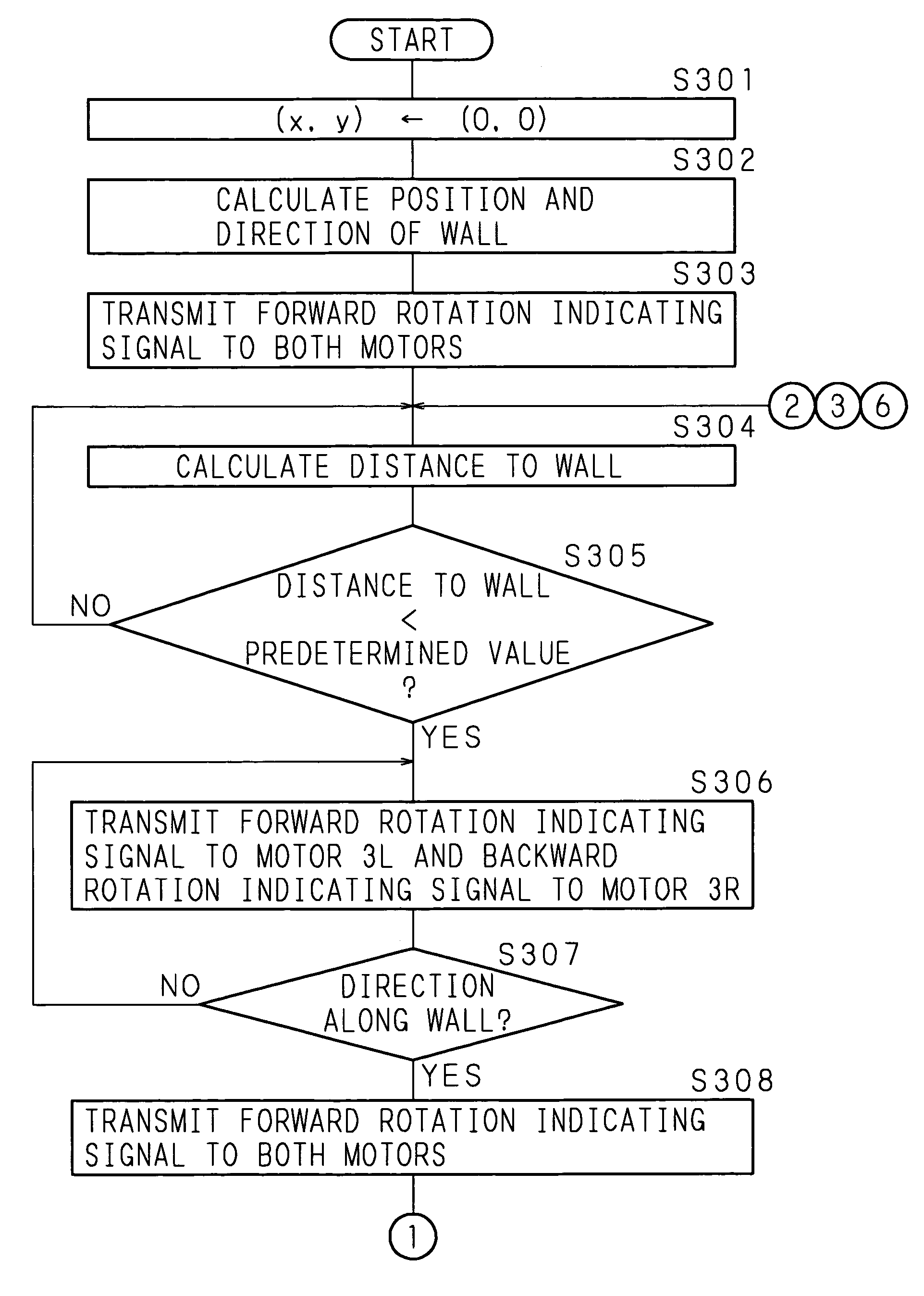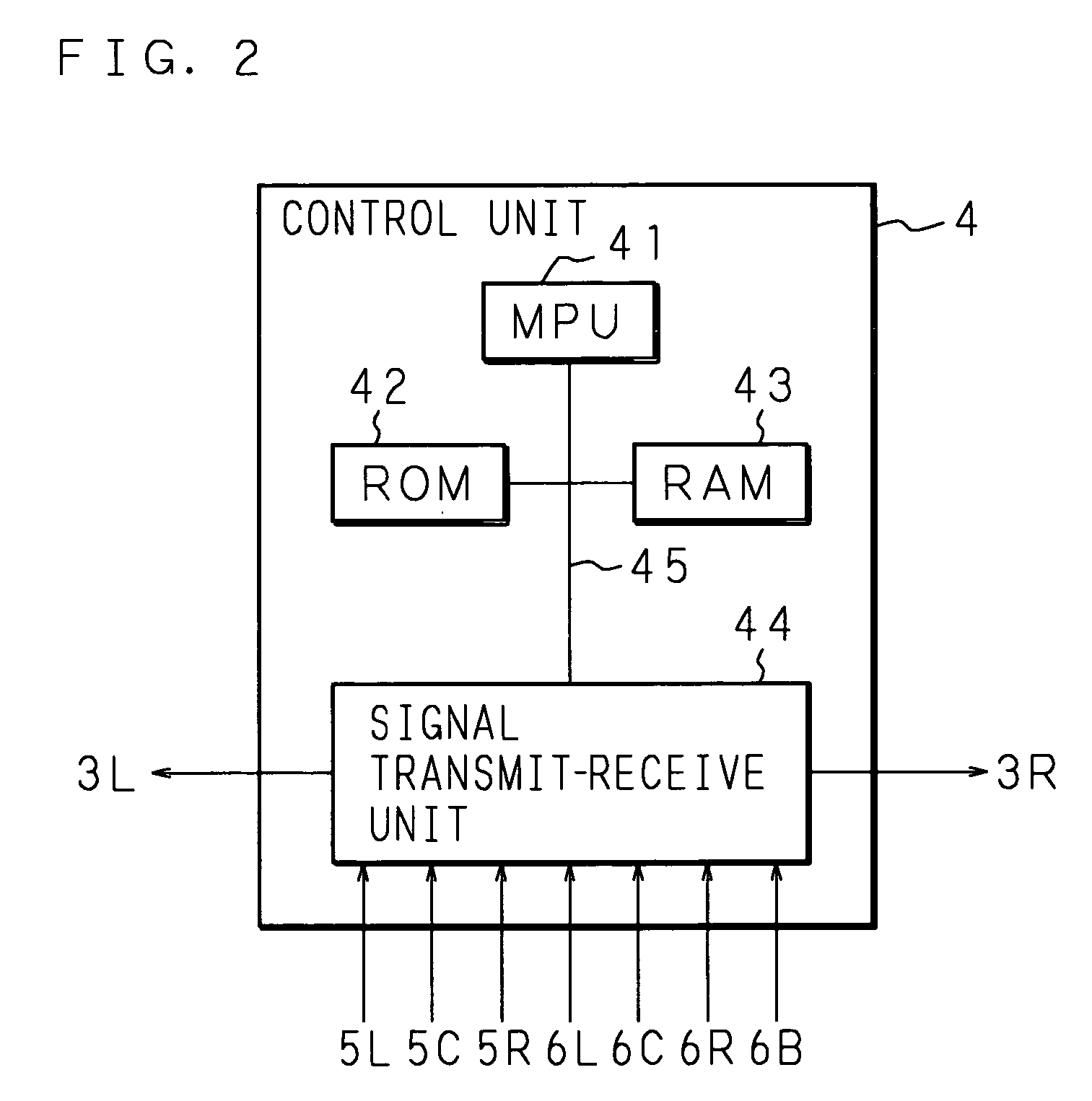Automotive movable body, movable body control method and computer program
a technology of movable bodies and control methods, applied in the direction of process and machine control, distance measurement, instruments, etc., can solve the problems of cleaning the entire area, cleaning cannot go away from obstacles, and cannot clean the entire area, so as to achieve high precision, high precision, and high precision
- Summary
- Abstract
- Description
- Claims
- Application Information
AI Technical Summary
Benefits of technology
Problems solved by technology
Method used
Image
Examples
embodiment 1
[0056]FIG. 1 is a block diagram showing an example of the schematic structure of an automotive movable body according to Embodiment 1 of the present invention. In FIG. 1, denoted at 1 is an automotive movable body, such as an automotive vacuum cleaner or an automotive lawn mower, which is used so as to move all over an area surrounded by a boundary such as a wall.
[0057] The automotive movable body 1 is composed of a pair of driven wheels 2L and 2R; a steering wheel 2C; motors 3L and 3R for driving the driven wheels 2L and 2R; a control unit 4 for controlling a drive of the motors; ultrasonic sensors 5L, 5C and 5R for detecting a wall, an obstacle or the like; and pressure sensors 6L, 6C, 6R and 6B for detecting a contact with a wall, an obstacle or the like.
[0058]FIG. 1 shows a state where the automotive movable body 1 is drawn in perspective from above a plane surface thereof and shows a left driven wheel 2L, a right driven wheel 2R and a steering wheel 2C. The axles of the left ...
embodiment 2
[0083] The following description will explain an automotive movable body 1 according to Embodiment 2 of the present invention. FIG. 8 is a flow chart showing a part of the operational control procedure of a control unit 4 of the automotive movable body 1 according to Embodiment 2 of the present invention. FIG. 8 illustrates a case where the body moves in a clockwise direction. It should be noted that the automotive movable body 1 according to Embodiment 2 of the present invention is the same as Embodiment 1 in construction and the detailed explanation thereof will be omitted by appending the same codes.
[0084] When the automotive movable body 1 is located in an area surrounded by a wall to start moving, the control unit 4 detects the position of the nearest surface of the wall on the basis of input signals from a plurality of sensors 5L, 5C and 5R. In particular, the MPU 41 resets the position coordinate counter (x, y) of the RAM 43 to (0, 0) when a moving start instruction is issue...
embodiment 3
[0096] Embodiment 3, which will explain an automotive movable body 1 according to Embodiment 3 of the present invention in the following description, is characterized in the moving control procedure to be performed after the automotive movable body 1 turns around at an approximately 180° and moves toward the wall. FIGS. 10, 11A and 11B are flow charts showing a part of the operational control procedure of a control unit 4 of the automotive movable body 1 according to Embodiment 3 of the present invention. FIGS. 10, 11A and 11B illustrate a case where the body moves in a clockwise direction. It should be noted that the automotive movable body 1 according to Embodiment 3 of the present invention is the same as Embodiment 1 in construction and the detailed explanation thereof will be omitted by appending the same codes.
[0097] The MPU 41 calculates the distance to a wall lying in front on the basis of signals inputted from ultrasonic sensors 5L, 5C and 5R (step S1001) and judges whethe...
PUM
 Login to View More
Login to View More Abstract
Description
Claims
Application Information
 Login to View More
Login to View More - R&D
- Intellectual Property
- Life Sciences
- Materials
- Tech Scout
- Unparalleled Data Quality
- Higher Quality Content
- 60% Fewer Hallucinations
Browse by: Latest US Patents, China's latest patents, Technical Efficacy Thesaurus, Application Domain, Technology Topic, Popular Technical Reports.
© 2025 PatSnap. All rights reserved.Legal|Privacy policy|Modern Slavery Act Transparency Statement|Sitemap|About US| Contact US: help@patsnap.com



